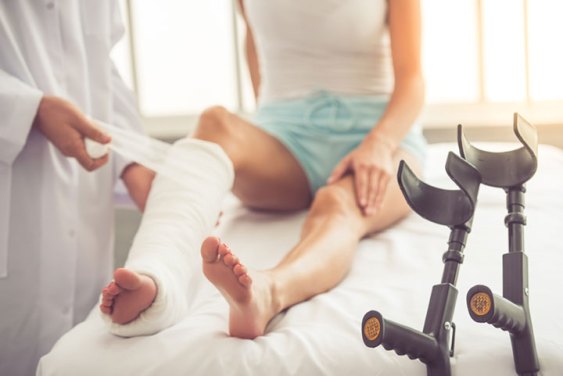During the COVID-19 virus pandemic, a large number of patients experience various types of injuries, both to the skeletal and muscular systems. The Atlas General Hospital has an Orthopedic and Arthroscopic Surgery Center that takes care of all types of orthopedic injuries even during a virus pandemic.
The advantage of modern times in all branches of medicine, including in orthopedics, is the possibility to use modern equipment, as well as a chance to apply a variety of methods of treatment.
Orthopedic injuries such as fractures – broken bones, require immediate medical attention.
What is bone fracture?
Fracture is a term that refers to a broken bones that typically occurs after a traumatic event, such as a fall, accident, or exercise.
A fracture or broken bones (lat. Fractura) is a mechanical injury characterized by damage to the soft tissues, interruption of bone continuity (lat. Fractura osseum) or cartilage (lat. Fractura cartilaginis) caused by an external force, strong enough to exceed the level of physiological elasticity of bone or cartilage. Fractures can occur as a result of injury or as a result of various diseases associated with changes in the structure and characteristics of bone tissue. The severity of the fracture depends on the extent of the damaged bone and their number. Multiple fractures of large bones can lead to damage to blood vessels with massive blood loss and traumatic shock.
Type of fractures
Fractures can be divided into complex, simple (closed fracures) and open fractures. Compound fractures involve injuries, in which broken bone impairs skin integrity, increasing the risk of infection. Simple fractures involve the dislocation of bone fragments, as well as the exposure of the fracture to possible penetration of the skin towards the external environment.
Although in most cases fractures are not life-threatening conditions, they do require immediate medical attention. The severity of the fracture depends on the localization and severity of the trauma as well as the degree of damage to the surrounding bone tissue. The primary goal of fracture healing is to allow the bone tissue and surrounding soft tissue to heal as quickly as possible.
Bone fracture is considered an emergency, qualified as serious bodily injury and requires immediate medical treatment.
Common signs and symptoms of a broken bone:
- Pain (dolor)
- Swelling (tumor)
- Local temperature increase (calor)
- Disabled function (functio laesa)
- Abnormal mobility of the bone –passive movements of bone fragments
- Crepitation
- Hematoma – the outflow of blood into the tissue
Symptoms can get worse during movement. It is necessary to avoid movements in people with fractures except in case of prevention of further complications and injuries.
The best information about a bone fracture is given by radiographic diagnostics. X ray is done in two directions (anteroposteriorly and profile) and may also be in supplementary directions (oblique recording). Atlas General Hospital performs all the necessary X ray diagnostics in short period of time.
Nonoperative fracture treatment
Non-operative treatment methods are repositioning, immobilization, and traction.
Immobilization
Immobilization of the injured segment or extremity is done by the principle of engaging two adjacent joints in a functional position. Temporary immobilization is performed with temporary aids, wire splint (Cramer’s, Tomas), wood and plastic materials, etc.
Reposition
It is performed mainly under general anesthesia not only to avoid soreness but also to provide total muscle relaxation. When in a satisfactory reposition, position of the fragments is established, a suitable gypsum (plaster) immobilization is set up, and for long fractures without dislocation a bracing is sufficient.
There are also specific variants of immobilizers of gypsum for humerus diaphyseal fractures, and specific gypsum for lower extremity bone fractures.
The following orthopedic interventions are practised at Atlas General Hospital:
- Shoulder stabilization
- Elbow surgery
- Hip surgery
- Knee surgery
- Foot surgery
- Ilizarov method
- Center for Arthroscopy and Sports Surgery
- Center for General Orthopedics and Traumatology
- Regenerative medicine
- Orthokin therapy
First aid for broken bones
- In cases involving open fractures, immediate medical attention is advised and continued pressure with the sterile gauze on the wound. Applying ice to injured part can also be helpful.
- In cases where fracture of the extremity has also led to impaired skin integrity, immobilization of the extremity and a thorough neurovascular examination are necessary.
- Bandaging involving the distal and proximal parts of the extremities may also be of benefit, without engaging the lesion site. The use of bandages should prevent movements, but not interfere with circulation and with moderate compression.
- If the person is unconscious or immobile, it is necessary to seek adequate help or apply cardiopulmonary resuscitation.
- Delicate first aid is required in the case of thoracic or vertebral fractures.
- It is necessary to avoid any movement as well as to urgently contact a healthcare facility for treatment and prevention of further complications.
What not to do with a fracture
The following maneuvers should not be attempted before the arrival of the medical emergency team:
- Avoid massaging the affected regions
- Avoid maneuvers for potential repositioning of captured segments
- Avoid applying ice directly to the skin (via fabric)
- Avoid removing clothes (cut clothes if necessary)
- Do not move a person with a suspected thoracic vertebral fracture
The Atlas Physics team offers you top professional services, licensed certified physiotherapists, Ackermann chiropractors, and physical medicine and rehabilitation specialists. Each patient is treated individually and with complete care and focus on recovering as quickly as possible.
Atlas physical has prepared a special promotional price “2 for 3,000 dinars” for the therapies of your choice. If you need physical therapy, chiropractic or traction (spinal decompression) you can now choose any two services at a price of 3,000 dinars.
For more information and to schedule an appointment, please call our call center on 0117858888 or 0628047468.









